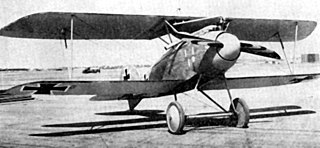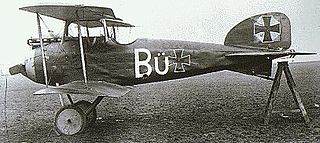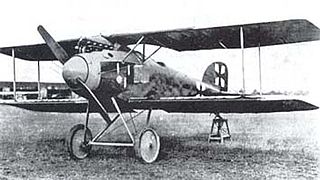Operators
 German Empire
German Empire
| Euler D.I | |
|---|---|
| Role | Fighter |
| Manufacturer | Euler-Werke |
| Designer | August Euler |
| First flight | Autumn 1916 |
| Introduction | 1917 |
| Retired | 1920 |
| Primary user | Luftstreitkräfte |
| Number built | around 75 |
| Variants | Euler D.II |
The Euler D.I was a German single-seat fighter based on the French Nieuport 11. After seeing the success of the French Nieuport 11 at the front, German designer August Euler set about to create a German aircraft based on the Nieuport design. The Euler D.I first flew in late 1916. It was powered by an 80 hp engine with the Euler patented machine gun on the front.
Two prototypes were recorded as being in service at the front in October 1916, and the German government ordered 50 in the same month. A further 50 were ordered in early 1917, but this order was largely transferred over to the D.I's successor, the Euler D.II. The plane saw very little combat service, being largely used as a fighter trainer for the remainder of the war.
Data from[ citation needed ]
General characteristics
Performance
Armament

The Nieuport 17 C.1 is a French sesquiplane fighter designed and manufactured by the Nieuport company during World War I. An improvement over the Nieuport 11, it was a little larger than earlier Nieuports and better adapted to the more powerful engine than the interim Nieuport 16. Aside from early examples, it had the new Alkan-Hamy synchronization gear, permitting the use of a fuselage-mounted synchronised Vickers gun firing through the propeller disc.

The Albatros D.III was a biplane fighter aircraft used by the Imperial German Army Air Service (Luftstreitkräfte) during World War I. A modified licensed version was built by Oeffag for the Austro-Hungarian Air Service (Luftfahrtruppen). The D.III was flown by many top German aces, including Wilhelm Frankl, Erich Löwenhardt, Manfred von Richthofen, Karl Emil Schäfer, Ernst Udet, and Kurt Wolff, and Austro-Hungarians like Godwin von Brumowski. It was the preeminent fighter during the period of German aerial dominance known as "Bloody April" 1917.

The Siemens-Schuckert D.IV was a late-World War I fighter aircraft from Siemens-Schuckert (SSW). It reached service too late and was produced in too few numbers to have any effect on the war effort.

The Albatros D.I was a German fighter aircraft used during World War I. Although its operational career was short, it was the first of the Albatros D types which equipped the bulk of the German and Austrian fighter squadrons (Jagdstaffeln) for the last two years of the war.

The Albatros D.II was a German fighter aircraft used during World War I. After a successful combat career in the early Jagdstaffeln, it was gradually superseded by the Albatros D.III.

The Nieuport 11, nicknamed the Bébé, is a French World War I single seat sesquiplane fighter aircraft, designed by Gustave Delage. It was the primary aircraft that ended the Fokker Scourge in 1916. The type saw service with several of France's allies, and gave rise to the series of "vee-strut" Nieuport fighters that remained in service into the 1920s.

The Fokker D.I was a development of the D.II fighter. The D.I was also flown in Austro-Hungarian service as a fighter trainer aircraft under the designation B.III. Confusing the matter further, both the D.II and D.I arrived at the Front in German service at similar times, in July–August 1916. The main designer was Martin Kreutzer.

The Halberstadt D.II was a biplane fighter aircraft developed and manufactured by German aircraft company Halberstädter Flugzeugwerke.

The Nieuport 12 was a French sesquiplane reconnaissance, fighter aircraft and trainer used by France, Russia, Great Britain and the United States during World War I. Later production examples were built as trainers and served widely until the late 1920s.

The Siemens-Schuckert D.I was a single-seat fighter built by Siemens-Schuckert Werke in 1916. It was a German copy of the French Nieuport 17 that was obsolete by the time it was available in numbers, so that it served mainly as an advanced trainer.

The Nieuport-Delage NiD.62 was a French sesquiplane fighter from the early 1930s. This machine was a descendant of a long line of Nieuport-Delage fighters that were designed and built during the years immediately after World War I. The NiD.62 was built in 1931 as a fighter for the Armée de l'Air. It served until the late 1930s, when it was replaced by more modern monoplane fighters. By the time of the outbreak of World War II in September 1939, all of the NiD.62s had been withdrawn from front-line fighter escadrilles but were used as trainers in French flight schools. A few aircraft were employed as target tugs. After the French German Armistice and German occupation of North and West part of France in June 1940, the German Luftwaffe had no interest in the NiD.62s and they were scrapped. None survived the war.

The Sikorsky S-20 or RBVZ S-XX was a Russian single-bay unequal span two-seat biplane designed by Igor Sikorsky in 1916. Displaying some Nieuport influence, it saw very little service during World War I.
The Euler D.II was a German single-seat fighter, the successor to the earlier Euler D.I. The D.II was essentially a re-engined Euler D.I, the air-frame being virtually unchanged and the power plant being a 100 hp Oberusel U I 9-cylinder rotary.

The Nieuport 14 was a military reconnaissance sesquiplane produced in France during the First World War. The French Army deployed it in 1916 but the type was quickly withdrawn from front-line service.
The Sopwith Snapper was a prototype British fighter aircraft of the First World War. A single-engined biplane designed by the Sopwith Aviation Company to replace the Sopwith Snipe fighter, it first flew after the end of the war, but did not enter service owing to the failure of its engine, only three aircraft being built.
The Circa Reproductions Nieuports are a family of Canadian 7/8 scale World War I sesquiplane aircraft replicas designed by Graham Lee of Lamont, Alberta for amateur construction from plans sold by Lee's company Circa Reproductions. Leading Edge Air Foils of Peyton, Colorado at one time also made construction kits available. Lee's Nieuports were among the earliest First World War replicas available and paved the way for later companies to produce plans and kits for a great variety of warbirds.

The Nieuport-Delage NiD 43 was a single-engine, two-seat biplane fighter aircraft designed and built for shipboard use in France in 1924.

The Nieuport 15 was a French World War I bomber aircraft. Due to disappointing performance the type was rejected and never entered service.
The Mosca-Bystritsky MBbis was a fighter aircraft developed and used by the Imperial Russian Air Service during the First World War.

The Nieuport 16 C.1 was a French World War I single-seat sesquiplane fighter aircraft, designed by Gustave Delage as a development of the Nieuport 11 with a more powerful engine. The Nieuport 16's service life coincided with the period when the first air-to-air rockets, the Le Prieur rocket, were used most frequently, and the type has a closer association with them than any other aircraft.